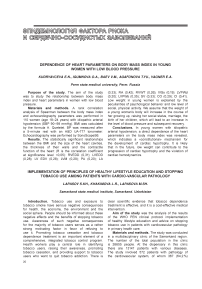Dependence of heart parameters on body mass index in young women with low blood pressure
Автор: Kudryavoeva E.N., Igumnova O.A., Baev V.M., Agafonova T.Yu., Vagner E.A.
Журнал: Евразийский кардиологический журнал @eurasian-cardiology-journal
Рубрика: Эпидемиология фактора риска и сердечно-сосудистых заболеваний
Статья в выпуске: S2, 2019 года.
Бесплатный доступ
The aim of the study was to study the relationship between body mass index and heart parameters in women with low blood pressure.
Короткий адрес: https://sciup.org/143170192
IDR: 143170192
Текст статьи Dependence of heart parameters on body mass index in young women with low blood pressure
(0,33); RA (0,42); RVWT (0,26); IVSs (0,19); LVPWd (0,20); LVPWs (0,35); SV (0,33); CO (0,29); CI (0,41). Low weight in young women is explained by the peculiarities of psychological behavior and low level of social, physical activity. We assume that the weight of a young woman’s body will increase in the course of her growing up, raising her social status, marriage, the birth of her children, which will lead to an increase in the level of blood pressure and subsequent recovery.
Conclusions. In young women with idiopathic arterial hypotension, a direct dependence of the heart parameters on the body mass index was revealed, which indicates a «constitutional» mechanism for the development of cardiac hypotrophy. It is likely that in the future, low weight can contribute to the progression of cardiac hypotrophy and the violation of cardiac hemodynamics.
IMPLEMENTATION OF PRINCIPLES OF HEALTHY LIFESTYLE EDUCATION AND STOPPING TOBACCO USE AMONG PATIENTS WITH CARDIO-VASCULAR PATHOLOGY
LAPASOV S.KH., KHAKIMOVA L.R., LAPASOVA M.SH.
Samarkand state medical institute, Samarkand. Uzbekistan
Introduction. Tobacco use and exposure to tobacco smoke have serious negative consequences for health, the economy, the environment and the social sphere. People should be informed about these negative effects and the benefits of stopping tobacco use. Awareness of such negative consequences for the majority of tobacco users serves as a rather strong motivating factor in favor of refusing to use it. Promoting tobacco cessation and tobacco dependence treatment is an important element of a comprehensive, integrated tobacco control program. Health workers play a central role in identifying tobacco users, raising their awareness, promoting tobacco cessation, and providing support to tobacco users who want to quit tobacco addiction. There is clear scientific evidence that tobacco dependence treatment is effective, and it is a cost-effective medical intervention.
Aim of the study was the analysis of the results of the WHO PEN clinical protocol implementation of healthy lifestyle education and advice on stopping tobacco use in patients with cardiovascular pathology in primary health care.
Materials and methods. The study was conducted in a multidisciplinary clinic of the Samarkand region. The number of the total population in the clinic is 26655 people. At the dispensary in this clinic there are 13147 patients with various diseases. The study involved 572 patients with pathology of the cardiovascular system, of whom 367 (64,2 %)


